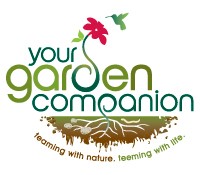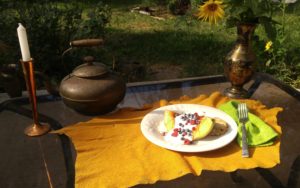
Humans depend on the same habitat as wildlife. Some of the plants and animals may differ but the processes are the same. On a half acre parcel, we had abundant raspberries, garlic, plums and green beans with enough food for winter preservation. Our natural areas provided the habitat for the pollinators and beneficial insects. We have 6 types of perennial berries on our half acre. This dish has four, can you identify them? Planting natural perennial strips of flowers between your beds is one way to foster pollinators and soil microbes, while growing your own food.
Roots to Cellar 2015

To fill your root cellar you need plenty of roots like potatoes and carrots. To have healthy roots, you need healthy soils. To have healthy soils you need a good compost pile. Here is my journey from compost heap to a “spudding” root cellar. You too can make it happen.
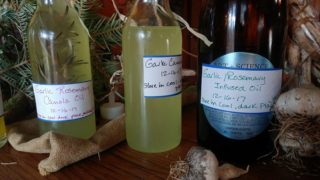
Soil for Spuds 2013-14
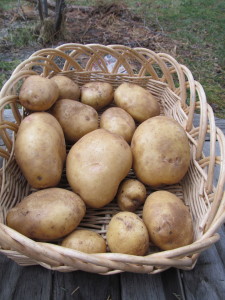
My composting process began as a heap of brush, old pine needles, pine cones, clumps of Kentucky blue grass (roots and all) and the exotic, invasive bindweed, a member of the morning glory family. For three years now I have been piling yard debris on the eastern side of my property in Bend Oregon.
The plan was to keep all organic matter on site. This would be more sustainable, with fewer trips hauling waste to the landfill and fewer dollars spent buying compost I could create! Normally one doesn’t try to compost the hard-to-kill weeds like bindweed and grasses that spread by underground roots or rhizomes. This meant experimenting on different ways to help them decompose and become compost. First I experimented with soaking the plants in water to deplete the roots of oxygen—both species survived. Finally, I decided to cover the growing pile. Then I walked away.
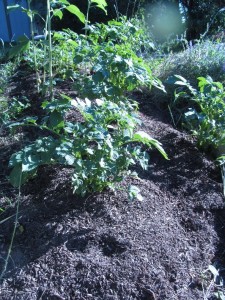
Spring Planting 2015
In the spring of 2015, the tarp came off. No real signs of bindweed vines or their curl-i-cue roots, no signs of sod or the rhizomes of grass, just pine straw decomposed into a fluffy compost. It might be just perfect for potatoes. The only thing I added was some peat to decrease make it more acidic which would provide the perfect soil chemistry needed to harness all the necessary nutrients in the perfect amounts to thrive.
I mixed one bag of peat, about two cubic feet, over a 10’ by 10’ area before planting. Peat is a very acidic soil amendment, with a pH of about 4.5 so when mixed with my soils that run about 7.0, it drops the pH while adding necessary organic matter to my sandy soils. According to expert gardener Elliot Coleman, Canadian peat is being replaced at a sustainable rate, otherwise I would try to alter the bed in a longer process using elemental sulfur. By mid-May, I had the spuds in the ground and by the end of August the plants were about two feet tall and producing tubers beneath the soil. A tuber is an underground stem that can produce a new plant from each bud or “eye” which looks like a dimple.
Spud Harvest and Storage 2015
The abundant harvest begged the question, “How and where should I store the potatoes most efficiently?” Once cured, potatoes need a cool, dark, moist environment, refrigerator-like conditions, with temperatures between 32 and 40 degrees Fahrenheit and 90 – 95% humidity. Some experts recommend keeping the potatoes around 38 – 40 degrees to prevent starches from turning to sugars at the cooler temperatures. The only problem is that most refrigerators do not have enough space for a large harvest.
Meanwhile, my freezer was not working adequately and needed a new sense of purpose…. Now there’s an idea! Convert my old freezer into a root cellar. I wasn’t sure how, but I knew someone had done it before. When talking with my new gardening assistant, Kammy Langdon, she happened to have an old book on how to convert a freezer into a root cellar– wah la!
Root Cellar Construction, November 2015
Despite it being November, Kammy and I embarked on my quest to build a root cellar Thanksgiving weekend, just about the time it snowed! Twelve inches. Kammy and her power tools made it all possible. First we stripped the old freezer down, hired a specialist remove the Freon, installed a simple ventilation system, placed it into the side of a berm on two sides, built up the walls, and added extra hay bales for insulation.
Insert, load, and test.
Monitoring temperature and humidity are essential to successful food storage so I purchased a digital wireless weather station with a combined thermometer and hygrometer so I could monitor the humidity and temperature from inside my house. It is available from La Crosse Technology.
Data Collected: 12-27-15
Outside Temperature: 25 F
Inside the root cellar: 34.5 F
Update: 12-29-15
Outside Temperature: 29 F
Inside the root cellar: 36.8 F

Then it was time to go peruse the gardening catalogs with a bowl of baked and buttered fingerlings with crushed dried herbs from the garden. I curled up on the big blue recliner and watched the snow fall.
Zucchinis – are they worth the effort?
You know when your gardening work is worth the effort when you harvest your first zucchini! Last weekend, I added plump juicy raspberries from my backyard vines into my zucchini bread recipe with whole grain flours and walnuts; the bread was a week long treat and flooded me with childhood memories.Where I grew up zucchini plants seemed to erupt from the fluffy, black Illinois soil. In July and August it was the plant that kept on giving. You knew it was the season when three people showed up at a potluck with zucchini bread. The local prank was to leave a zucchini on your neighbor’s doorstep, ring the doorbell and RUN! That’s when you used to pick them close to 2 feet long and 3 inches diameter—nearly a monster.
Here in the cool pockets of Bend and Central Oregon, zucchinis, are a warm season crop that takes more effort to grow, especially since a frost can occur almost any time of year. Zucchinis are a member of the squash family, Cucurbitaceae, (cue-ker-bi-tay-cee-ay) which does very well once the summer season gets started. They need soil temperatures of 70 – 95 degrees Fahrenheit to germinate, and similar conditions to grow harvesting in 60 – 80 days depending upon your microclimate and the number of cool evenings we have.
Since it takes so much effort and space, I decided not to grow zucchini, but rather to grow tomatoes. To create a warm environment for tomatoes I built a small hoop house with heavy plastic and electrical conduit piping. Then I added fresh manure as an active composting layer beneath about 4 inches of topsoil. Apparently, the manure housed several zucchini seeds which sprouted once the soil warmed. Not only did the hoop house protect the young plants from freezing in June, but it protected them from hail storms and extreme temperatures in July and August. As temperatures cool in the fall, the hoop house will also extend the season.
Sounds like growing zucchini isn’t too hard after all; is that all the effort necessary to get those abundant log-sized veggies? It is not too hard if you have the time to invest in a hoop house and yes it is worth the effort; however, it is not just the environment you need to produce the “fruit”.
Cross pollination
To get the “fruit” or what we call the zucchini, cross pollination is essential, since the pollen must be moved from the male flower to the female flower for fertilization to occur.
Male zucchini squash blossom, by Yvonne Babb 8/2014
While you are pressing the snooze button or drinking your morning java, squash bees are already courting or mating amongst the open squash blossoms. While gathering pollen and nectar they are moving the pollen between the male and female flowers, or cross pollinating.
Bee on female squash blossom.
This tradeoff is of mutual benefit to the insects which mate and then carry on with their life cycle. The female bee will collect pollen to feed the eggs she will lay in a tunnel in the soil, often beneath the squash plants a foot or more down. While the female is nest building, you might find the male taking a midday siesta in the spent blossom that twists its way closed for business.
I was so fascinated by these squash bees I strolled out to the garden between 5:30am and 7:30am in early August, coffee in hand, to check them out. At first I saw nothing, but then within 5 minutes I saw a robust bee land on the male flower. It crawled around, became coated with pollen and flew off. Only three squash blossoms were open and receptive, so it soon landed on the only female flower, crawled in and circled the brain-like female pistil, wa-la! Maybe I will have zucchini after all.
Pollinators in Synch
By the time the exotic honeybees arose mid-day, most of my zucchini flowers may have already been pollinated for now they were tightly closed. This is why native bees can be more effective pollinators, for the timing of the native plant and the native pollinator is in synch.
According to a Nature Conservancy Analysis of Native Pollinator Benefits to New Jersey Farms, native bees are twice as effective as managed honeybees at pollination which was demonstrated by a large team of researchers across a wide array of crops around the globe. Additional research by Vaughan found that in many cases squash bees can provide up to 100% of the squash plant’s pollination needs.
Only two groups of pollinators
There are only two groups of native North American squash bees (Peponapis and Xenoglossa) which are highly specialized in pollinating squash flowers. They specifically seek out pollen and nectar from melons, pumpkins, squash, cucumbers and gourds.
If the bees have quality habitat, then the farmer or gardener does not need to supplement the native bees with managed honeybees. In the Nature Conservancy Squash Fact Sheet, the squash bees support the 9.6 million dollar New Jersey squash industry; however, as human populations increase and habitat for bees’ declines, farmers may need to compensate by using and paying for managed honey bees, which are obviously not on the same schedule as the squash plant as described above.
Creating habitat
All animals need their preferred food, water, shelter and adequate space to survive, collectively its habitat. To ensure squash bees have adequate habitat in your yard follow these simple steps:
- Avoid deep tillage to prevent damaging bees’ nests (According to the Ontario Ministry of Agriculture, squash bees build vertical underground tunnels with 3-5 lateral side channels that end in a brood cell where the female lays an egg and deposits a pollen ball before capping off the chamber so the egg can develop. The side channels are only about 4 inches deep.
- Keep south facing slopes and warm areas of exposed soil weed free for bee nesting.
- Some bees like heavier soils with more clay for nesting and others prefer sand
- Provide a source of water by maintaining a shallow canal or depressions in the fields that hold water. These can be created by sinking planter trays or bird baths in the soil and filling them half way with sloping gravel to ensure bees have safe access to the water. Avoid overhead watering during the early morning hours to prevent washing pollen off the flowers.
- Choose a toxic free environment. Pesticides, insecticides and fungicides can all be harmful to soft bodied bees that can accumulate toxins in their bodies over time.
- One especially harmful group of synthetic insecticides associated with bee declines is Neonicotinoids; they are absorbed throughout the plant, persist for long periods in the environment, and can accumulate in the organisms that absorb them or eat any part of the plant. Read more about these insecticides on the Farms at Work website factsheet by Susan Chan or xerces.org/pesticides.
- Pesticides that contain dinotefuran or imidacloprid (neonicotinoids) are currently banned by the Oregon Department of Agriculture for use on Linden or Basswood Trees and other Tilia species, until Dec. 23, 2014; however, they are still sold commercially for use on a variety of other ornamental and food crops.
I have the hoop house. I have the raised beds. I have a source of fresh manure and I have created healthy bee habitat. I am sold! Watch out, you just may get a zucchini on your doorstep next season and I highly advise you to make bread and join the fun. Take your coffee and camera out to the pumpkin patch for a short documentary at dawn that you won’t regret!
Teaming with Nature, Teeming with Life!
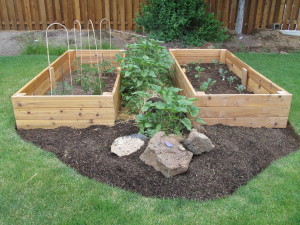
By nurturing the wild components of the landscape–the natural services of birds, insects, soil microbes, worms and pollinators – the agricultural crops benefit from an integrated approach to pest management.
By fostering organic processes, we maintain a healthy landscape and garden without the need for herbicides, pesticides or excessive soil amendments.

